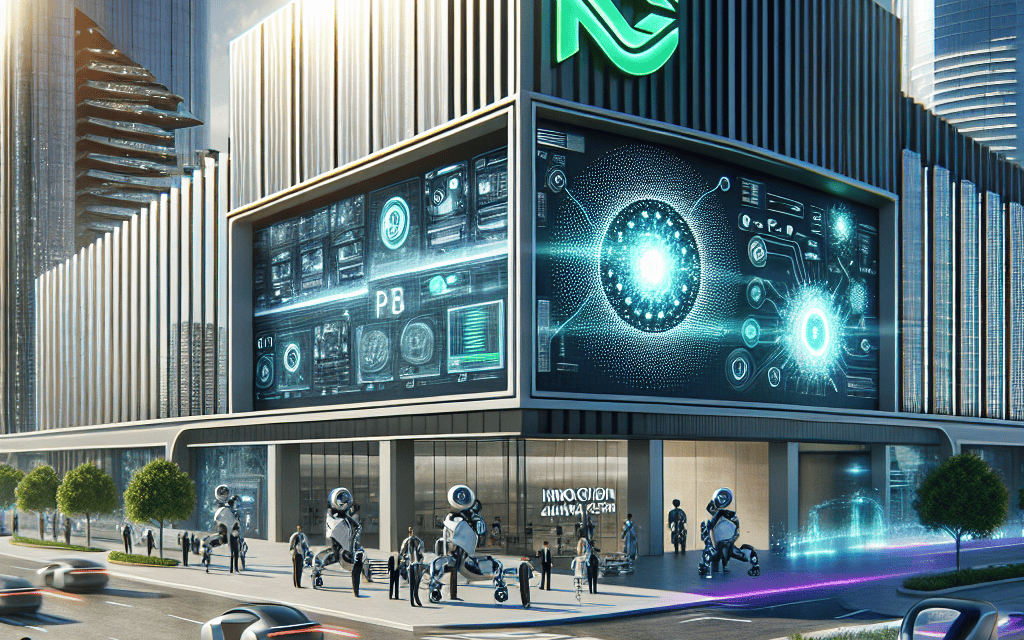“Propelling Innovation: Nvidia’s Next Leap Forward in a Year”
Introduction
Nvidia, a leading player in the semiconductor industry, has consistently demonstrated its prowess in graphics processing units (GPUs) and artificial intelligence (AI) technologies. As the company continues to innovate and expand its influence across various sectors, the question of where Nvidia will be in one year is intriguing. With its strategic investments in AI, data centers, autonomous vehicles, and gaming, Nvidia is poised for significant growth. The company’s focus on cutting-edge technologies, such as AI-driven solutions and high-performance computing, positions it well to capitalize on emerging trends. Additionally, Nvidia’s potential mergers and acquisitions, along with its robust research and development efforts, could further solidify its market position. As the demand for advanced computing solutions continues to rise, Nvidia’s trajectory over the next year will likely be shaped by its ability to adapt to evolving market dynamics and leverage its technological expertise.
Market Position: Nvidia’s Competitive Edge in 2024
Nvidia, a titan in the semiconductor industry, has consistently demonstrated its prowess in the realm of graphics processing units (GPUs) and artificial intelligence (AI) technologies. As we look ahead to 2024, Nvidia’s market position appears poised for further consolidation and expansion, driven by its innovative strategies and robust product offerings. The company’s competitive edge is underpinned by several key factors that are likely to shape its trajectory over the next year.
To begin with, Nvidia’s commitment to research and development (R&D) remains a cornerstone of its competitive advantage. The company has consistently invested a significant portion of its revenue into R&D, ensuring that it stays at the forefront of technological advancements. This dedication has enabled Nvidia to introduce cutting-edge products that cater to a wide array of industries, from gaming and data centers to automotive and healthcare. As the demand for high-performance computing continues to rise, Nvidia’s ability to innovate and deliver superior products will be crucial in maintaining its market leadership.
Moreover, Nvidia’s strategic acquisitions have played a pivotal role in enhancing its competitive position. The acquisition of Mellanox Technologies, for instance, has strengthened Nvidia’s data center offerings by integrating high-performance networking solutions. This move has not only expanded Nvidia’s product portfolio but also allowed it to tap into new markets and customer segments. Looking ahead, Nvidia’s strategic focus on mergers and acquisitions is likely to continue, enabling the company to bolster its capabilities and maintain its edge over competitors.
In addition to its technological prowess, Nvidia’s strong brand reputation and customer loyalty are significant assets. The company’s GPUs are renowned for their performance and reliability, making them the preferred choice for gamers, professionals, and enterprises alike. This brand equity provides Nvidia with a competitive buffer, allowing it to command premium pricing and maintain healthy profit margins. As the gaming industry continues to grow and evolve, Nvidia’s established presence and loyal customer base will be instrumental in sustaining its market dominance.
Furthermore, Nvidia’s foray into AI and machine learning has opened up new avenues for growth. The company’s AI platforms are being increasingly adopted across various sectors, including autonomous vehicles, robotics, and cloud computing. As AI becomes more integral to business operations and consumer applications, Nvidia’s expertise in this domain positions it well to capitalize on emerging opportunities. The company’s ability to provide comprehensive AI solutions, from hardware to software, gives it a distinct advantage in capturing a larger share of this burgeoning market.
However, it is important to acknowledge the challenges that Nvidia may face in the coming year. The semiconductor industry is highly competitive, with rivals such as AMD and Intel constantly vying for market share. Additionally, global supply chain disruptions and geopolitical tensions could pose risks to Nvidia’s operations and growth prospects. Nevertheless, Nvidia’s proactive approach to risk management and its strategic partnerships with key players in the industry are likely to mitigate these challenges.
In conclusion, Nvidia’s competitive edge in 2024 will be shaped by its relentless focus on innovation, strategic acquisitions, strong brand reputation, and leadership in AI technologies. While challenges remain, the company’s robust market position and forward-looking strategies suggest that it is well-equipped to navigate the evolving landscape and continue its trajectory of growth and success. As we anticipate the developments of the coming year, Nvidia’s ability to adapt and thrive in a dynamic environment will be a testament to its enduring strength and vision.
Technological Innovations: What to Expect from Nvidia Next Year
Nvidia, a leader in the field of graphics processing units (GPUs) and artificial intelligence (AI), has consistently pushed the boundaries of technological innovation. As we look ahead to the next year, it is essential to consider the potential advancements and strategic moves that could shape Nvidia’s trajectory. The company has been at the forefront of AI and machine learning, and it is likely to continue its focus on these areas, given the increasing demand for AI-driven solutions across various industries. With AI becoming more integrated into everyday applications, Nvidia’s GPUs are expected to play a crucial role in powering these technologies, offering enhanced performance and efficiency.
Moreover, Nvidia’s recent foray into the automotive sector with its DRIVE platform suggests that the company is keen on expanding its influence beyond traditional computing. The DRIVE platform, which provides AI-powered solutions for autonomous vehicles, is likely to see further development and adoption in the coming year. As the automotive industry continues to evolve towards self-driving technology, Nvidia’s expertise in AI and deep learning could position it as a key player in this transformative space.
In addition to its focus on AI and autonomous vehicles, Nvidia is also expected to make significant strides in the gaming industry. The company’s GPUs have long been a staple for gamers, and with the advent of more sophisticated gaming experiences, Nvidia is likely to introduce new products that cater to the demands of high-performance gaming. The introduction of ray tracing technology in recent years has already set a new standard for visual realism in games, and Nvidia is poised to further enhance this technology, providing gamers with even more immersive experiences.
Furthermore, Nvidia’s strategic acquisitions and partnerships could play a pivotal role in its growth over the next year. The company’s acquisition of ARM, a leading semiconductor and software design company, is expected to bolster Nvidia’s capabilities in the mobile and embedded systems markets. This acquisition, once fully integrated, could open up new avenues for innovation and collaboration, allowing Nvidia to tap into ARM’s extensive ecosystem and expertise.
As Nvidia continues to innovate, it is also likely to face challenges, particularly in the realm of competition and regulatory scrutiny. The tech industry is highly competitive, with companies like AMD and Intel constantly vying for market share. Nvidia will need to maintain its competitive edge by continuing to invest in research and development, ensuring that its products remain at the cutting edge of technology. Additionally, regulatory challenges, particularly concerning its acquisitions and market dominance, could pose hurdles that Nvidia will need to navigate carefully.
In conclusion, the next year promises to be an exciting period for Nvidia as it continues to drive technological innovation across multiple sectors. With its focus on AI, autonomous vehicles, gaming, and strategic partnerships, Nvidia is well-positioned to maintain its leadership in the tech industry. However, the company will need to remain vigilant in addressing competitive pressures and regulatory challenges to sustain its growth and success. As we anticipate these developments, it is clear that Nvidia’s influence on the technological landscape will only continue to grow, shaping the future of computing and beyond.
Financial Forecast: Nvidia’s Revenue and Growth Projections
Nvidia, a leading player in the semiconductor industry, has consistently demonstrated its prowess in developing cutting-edge graphics processing units (GPUs) and artificial intelligence (AI) technologies. As we look ahead to the next year, the financial forecast for Nvidia appears promising, driven by several key factors that are expected to influence its revenue and growth projections. To begin with, the increasing demand for AI and machine learning applications is likely to play a significant role in Nvidia’s financial trajectory. The company’s GPUs are integral to AI workloads, providing the computational power necessary for training complex models. As industries such as healthcare, automotive, and finance continue to integrate AI into their operations, Nvidia is well-positioned to capitalize on this trend. Consequently, the demand for its products is expected to rise, potentially leading to substantial revenue growth.
Moreover, the gaming industry remains a crucial revenue stream for Nvidia. With the ongoing popularity of gaming and the advent of new gaming technologies, Nvidia’s GPUs are in high demand among both casual and professional gamers. The company’s commitment to innovation, as evidenced by its recent product launches, ensures that it remains at the forefront of the gaming hardware market. This sustained demand is likely to contribute positively to Nvidia’s financial performance over the next year. In addition to gaming and AI, Nvidia’s expansion into the data center market is another factor that could drive its growth. The increasing reliance on cloud computing and data analytics has created a burgeoning market for data center solutions. Nvidia’s GPUs are not only essential for AI workloads but also for accelerating data processing in data centers. As more companies migrate to cloud-based infrastructures, Nvidia’s data center business is poised for significant growth, further bolstering its revenue prospects.
Furthermore, Nvidia’s strategic acquisitions and partnerships are expected to enhance its market position and financial outlook. The company’s acquisition of Mellanox Technologies, for instance, has strengthened its capabilities in high-performance computing and networking. Such strategic moves enable Nvidia to diversify its product offerings and tap into new markets, thereby creating additional revenue streams. As these acquisitions and partnerships mature, they are likely to contribute positively to Nvidia’s financial performance in the coming year. However, it is important to consider potential challenges that could impact Nvidia’s growth trajectory. The semiconductor industry is highly competitive, with companies like AMD and Intel vying for market share. Additionally, global supply chain disruptions and geopolitical tensions could pose risks to Nvidia’s operations and revenue growth. Despite these challenges, Nvidia’s strong market position and innovative product portfolio provide a solid foundation for navigating potential obstacles.
In conclusion, Nvidia’s financial forecast for the next year appears optimistic, driven by the growing demand for AI and gaming technologies, expansion into the data center market, and strategic acquisitions. While challenges exist, the company’s robust market position and commitment to innovation are likely to support its revenue and growth projections. As Nvidia continues to leverage its strengths and adapt to evolving market dynamics, it is well-equipped to maintain its leadership in the semiconductor industry and achieve sustained financial success.
AI and Machine Learning: Nvidia’s Role in the Future of AI

Nvidia has long been a pivotal player in the realm of artificial intelligence and machine learning, consistently pushing the boundaries of what is possible with its cutting-edge technology. As we look ahead to the next year, Nvidia’s role in the future of AI is poised to become even more significant, driven by its relentless innovation and strategic positioning within the industry. The company’s advancements in GPU technology have already revolutionized AI research and applications, providing the computational power necessary to train complex models and process vast amounts of data efficiently. This foundation sets the stage for Nvidia to further cement its influence in the AI landscape over the coming year.
One of the key areas where Nvidia is expected to make substantial strides is in the development of more powerful and efficient GPUs. The demand for high-performance computing continues to grow, fueled by the increasing complexity of AI models and the need for real-time data processing. Nvidia’s commitment to enhancing its hardware capabilities is likely to result in the release of next-generation GPUs that offer even greater speed and efficiency. These advancements will not only benefit AI researchers and developers but also have a ripple effect across various industries, from healthcare to autonomous vehicles, where AI is becoming an integral part of operations.
In addition to hardware innovations, Nvidia’s software ecosystem is another critical component of its strategy to shape the future of AI. The company’s CUDA platform and deep learning libraries have become essential tools for AI practitioners, enabling them to optimize their models and accelerate development processes. Over the next year, Nvidia is expected to continue refining and expanding its software offerings, making them more accessible and versatile for a broader range of applications. This will likely include enhancements to its AI frameworks and the introduction of new tools that simplify the deployment of AI solutions across different environments.
Moreover, Nvidia’s strategic partnerships and collaborations will play a crucial role in its trajectory over the next year. By aligning with leading technology companies, research institutions, and industry leaders, Nvidia can leverage collective expertise and resources to drive innovation in AI. These collaborations are expected to yield breakthroughs in areas such as natural language processing, computer vision, and robotics, further solidifying Nvidia’s position as a leader in AI technology. Additionally, Nvidia’s involvement in initiatives aimed at democratizing AI access and education will contribute to the broader adoption and understanding of AI technologies worldwide.
Furthermore, Nvidia’s focus on sustainability and energy efficiency is likely to gain prominence in the coming year. As the environmental impact of AI and high-performance computing becomes a growing concern, Nvidia’s efforts to develop energy-efficient technologies will be crucial. By prioritizing sustainability, Nvidia not only addresses environmental challenges but also aligns with the increasing demand for eco-friendly solutions in the tech industry.
In conclusion, Nvidia’s role in the future of AI is set to expand significantly over the next year, driven by advancements in hardware, software, strategic partnerships, and sustainability initiatives. As the company continues to innovate and adapt to the evolving needs of the AI landscape, it is well-positioned to remain at the forefront of AI technology, shaping the way we interact with and benefit from artificial intelligence in various aspects of our lives. The coming year promises to be an exciting period of growth and transformation for Nvidia, with far-reaching implications for the future of AI.
Gaming Industry: Nvidia’s Impact on Next-Gen Gaming
Nvidia, a titan in the technology sector, has long been a pivotal player in the gaming industry, consistently pushing the boundaries of what’s possible in next-generation gaming. As we look ahead to the coming year, Nvidia’s influence on the gaming landscape is poised to grow even more pronounced. The company’s innovative technologies and strategic partnerships are set to redefine gaming experiences, making them more immersive and visually stunning than ever before.
To begin with, Nvidia’s advancements in graphics processing units (GPUs) are at the forefront of this transformation. The company’s latest line of GPUs, built on the Ada Lovelace architecture, promises to deliver unprecedented levels of performance and efficiency. These GPUs are designed to handle the most demanding gaming environments, providing gamers with smoother frame rates and richer graphics. As developers continue to harness the power of these GPUs, we can expect to see games that are not only more visually impressive but also more complex and interactive.
Moreover, Nvidia’s commitment to real-time ray tracing technology is set to further enhance the realism of next-gen games. Ray tracing, which simulates the way light interacts with objects in a virtual environment, has been a game-changer in terms of visual fidelity. Nvidia’s RTX technology has already set a new standard for lighting, shadows, and reflections in gaming. Over the next year, as more developers adopt this technology, we can anticipate a significant leap in the quality of in-game graphics, making virtual worlds more lifelike than ever before.
In addition to hardware advancements, Nvidia’s software innovations are also shaping the future of gaming. The company’s AI-driven technologies, such as DLSS (Deep Learning Super Sampling), are revolutionizing the way games are rendered. By using artificial intelligence to upscale lower-resolution images in real-time, DLSS allows for higher performance without compromising on image quality. This technology not only enhances the gaming experience but also extends the lifespan of existing hardware, making high-quality gaming more accessible to a broader audience.
Furthermore, Nvidia’s strategic partnerships with game developers and other tech companies are crucial in driving the next wave of gaming innovation. Collaborations with leading game studios ensure that Nvidia’s technologies are seamlessly integrated into the latest titles, optimizing performance and enhancing gameplay. Additionally, partnerships with cloud gaming platforms like GeForce Now are expanding the reach of high-quality gaming experiences, allowing players to enjoy cutting-edge games on a variety of devices without the need for expensive hardware.
As we consider Nvidia’s trajectory over the next year, it is clear that the company is not only focused on enhancing the technical aspects of gaming but also on improving the overall user experience. Initiatives such as Nvidia Reflex, which reduces system latency, are designed to provide gamers with a competitive edge, particularly in fast-paced, multiplayer environments. These efforts underscore Nvidia’s commitment to delivering a comprehensive gaming experience that caters to both casual and hardcore gamers alike.
In conclusion, Nvidia’s impact on next-gen gaming over the coming year is expected to be profound. Through a combination of cutting-edge hardware, innovative software solutions, and strategic partnerships, Nvidia is set to elevate the gaming experience to new heights. As the company continues to push the envelope, gamers around the world can look forward to a future where virtual worlds are more immersive, interactive, and accessible than ever before.
Strategic Partnerships: Nvidia’s Collaborations and Alliances
Nvidia, a leader in the technology sector, has consistently demonstrated its ability to innovate and adapt in a rapidly changing market. As we look ahead to the next year, one of the key factors that will influence Nvidia’s trajectory is its strategic partnerships and alliances. These collaborations are not only pivotal for Nvidia’s growth but also for maintaining its competitive edge in the industry. By examining Nvidia’s current and potential partnerships, we can gain insight into where the company might be in a year’s time.
To begin with, Nvidia’s collaboration with major cloud service providers such as Amazon Web Services (AWS), Microsoft Azure, and Google Cloud has been instrumental in expanding its reach in the artificial intelligence (AI) and machine learning (ML) domains. These partnerships allow Nvidia to integrate its powerful GPUs into cloud infrastructures, thereby enabling businesses to leverage high-performance computing without the need for significant on-premises investment. As cloud computing continues to grow, Nvidia’s alliances with these tech giants are likely to deepen, potentially leading to new product offerings and enhanced services that cater to a broader range of industries.
Moreover, Nvidia’s acquisition of Arm Holdings, a deal that has been under intense scrutiny, could significantly reshape its strategic alliances. If the acquisition is finalized, it would position Nvidia to collaborate more closely with a vast array of companies that rely on Arm’s architecture, from smartphone manufacturers to automotive firms. This could open up new avenues for Nvidia to integrate its AI capabilities into a wider array of devices, thereby expanding its influence across different sectors. The potential synergies from this acquisition could also lead to innovative solutions that combine Nvidia’s GPU prowess with Arm’s energy-efficient designs, offering compelling products for emerging markets such as edge computing and the Internet of Things (IoT).
In addition to these high-profile partnerships, Nvidia has been actively engaging with automotive companies to advance autonomous driving technologies. Collaborations with firms like Mercedes-Benz and Toyota highlight Nvidia’s commitment to becoming a key player in the automotive industry. By providing the computational power necessary for autonomous vehicles, Nvidia is positioning itself at the forefront of this transformative technology. Over the next year, we can expect Nvidia to strengthen these alliances, potentially leading to breakthroughs that bring fully autonomous vehicles closer to reality.
Furthermore, Nvidia’s partnership with leading research institutions and universities is another strategic move that could bear fruit in the coming year. By collaborating with academia, Nvidia not only fosters innovation but also ensures that it remains at the cutting edge of technological advancements. These partnerships facilitate the development of new algorithms and applications that can be integrated into Nvidia’s product offerings, thereby enhancing its value proposition to customers.
In conclusion, Nvidia’s strategic partnerships and alliances are a cornerstone of its growth strategy. As the company navigates the complexities of the technology landscape, these collaborations will play a crucial role in determining its success. By leveraging its relationships with cloud providers, automotive companies, and research institutions, Nvidia is well-positioned to capitalize on emerging opportunities. Over the next year, we can anticipate that Nvidia will continue to forge and strengthen these alliances, ensuring that it remains a dominant force in the tech industry.
Stock Performance: Analyzing Nvidia’s Market Trends in 2024
Nvidia Corporation, a leading player in the semiconductor industry, has consistently captured the attention of investors and analysts alike. As we look ahead to 2024, the question of where Nvidia will stand in the stock market becomes increasingly pertinent. To understand Nvidia’s potential trajectory, it is essential to consider several key factors that could influence its stock performance over the next year.
First and foremost, Nvidia’s position in the rapidly evolving artificial intelligence (AI) and machine learning sectors cannot be overstated. The company’s GPUs are integral to AI applications, and as demand for AI technologies continues to surge, Nvidia is well-positioned to capitalize on this trend. The increasing adoption of AI across various industries, from healthcare to automotive, suggests a robust market for Nvidia’s products. Consequently, this could lead to sustained revenue growth, which is likely to be reflected in its stock performance.
Moreover, Nvidia’s strategic acquisitions and partnerships play a crucial role in its market positioning. The company’s acquisition of Arm Holdings, although facing regulatory hurdles, is a significant move that could enhance its capabilities in the semiconductor space. If successfully completed, this acquisition would provide Nvidia with access to Arm’s extensive ecosystem, potentially driving innovation and expanding its market reach. Additionally, partnerships with major tech companies could further bolster Nvidia’s growth prospects, as collaborations often lead to the development of cutting-edge technologies and solutions.
Transitioning to the gaming industry, Nvidia’s dominance in the graphics card market remains a critical component of its business model. The gaming sector has experienced substantial growth, partly fueled by the increasing popularity of e-sports and virtual reality. Nvidia’s GeForce RTX series continues to set benchmarks for performance, and with the anticipated release of new gaming titles and consoles, demand for high-performance graphics cards is expected to remain strong. This sustained demand could positively impact Nvidia’s financial performance, thereby influencing its stock valuation.
However, it is important to consider potential challenges that Nvidia may face in 2024. The semiconductor industry is characterized by rapid technological advancements and intense competition. Companies such as AMD and Intel are continuously innovating, striving to capture a larger share of the market. Nvidia must remain at the forefront of technological development to maintain its competitive edge. Furthermore, global supply chain disruptions, which have affected the semiconductor industry in recent years, could pose risks to Nvidia’s production capabilities and, consequently, its stock performance.
In addition to these industry-specific factors, broader economic conditions will also play a role in shaping Nvidia’s market trends. Inflationary pressures, interest rate fluctuations, and geopolitical tensions are macroeconomic variables that could impact investor sentiment and market dynamics. Nvidia’s ability to navigate these external challenges while maintaining its growth trajectory will be crucial in determining its stock performance over the next year.
In conclusion, Nvidia’s stock performance in 2024 will likely be influenced by a combination of its strategic initiatives, industry trends, and macroeconomic factors. The company’s strong position in the AI and gaming sectors, coupled with potential benefits from strategic acquisitions and partnerships, suggests a positive outlook. However, challenges such as competition and supply chain disruptions must be carefully managed. As investors and analysts continue to monitor these developments, Nvidia’s ability to adapt and innovate will be key to its success in the coming year.
Q&A
1. **Question:** What is Nvidia’s current market position?
**Answer:** Nvidia is a leading company in the graphics processing unit (GPU) market and a key player in AI and data center technologies.
2. **Question:** How might Nvidia’s stock price change in the next year?
**Answer:** Nvidia’s stock price could fluctuate based on market conditions, technological advancements, and financial performance, but predicting exact changes is speculative.
3. **Question:** What technological advancements could Nvidia make in the next year?
**Answer:** Nvidia may continue to innovate in AI, machine learning, and GPU technology, potentially releasing new products or updates to existing lines.
4. **Question:** How could Nvidia’s partnerships impact its future?
**Answer:** Strategic partnerships with tech companies and industries could enhance Nvidia’s market reach and technological capabilities, potentially boosting growth.
5. **Question:** What challenges might Nvidia face in the next year?
**Answer:** Nvidia could face challenges such as supply chain disruptions, increased competition, and regulatory scrutiny.
6. **Question:** How might Nvidia’s role in AI development evolve?
**Answer:** Nvidia is likely to expand its influence in AI development through advancements in hardware and software solutions, supporting various AI applications.
7. **Question:** What is the potential impact of global economic conditions on Nvidia?
**Answer:** Global economic conditions, such as inflation or recession, could affect consumer spending and investment in technology, impacting Nvidia’s sales and growth.
Conclusion
Nvidia is likely to continue its strong performance over the next year, driven by its leadership in the graphics processing unit (GPU) market, advancements in artificial intelligence (AI), and expansion into data centers and autonomous vehicles. The company’s strategic investments in AI and machine learning, along with its partnerships and acquisitions, position it well for growth. However, potential challenges such as supply chain constraints, increased competition, and regulatory scrutiny could impact its trajectory. Overall, Nvidia is expected to maintain its growth momentum, but investors should remain vigilant about market dynamics and external factors.





